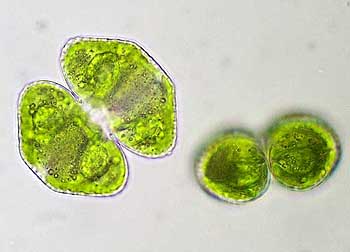

Of all the groups in the kingdom Protista, this is the one which is most directly relevant to botanists. This is because plants are believed to have evolved from the green algae. There are several lines of evidence that lead us to this conclusion:
1. Green algae have the same photosynthetic pigments as plants (Chlorophylls a & b)
2. They store their food as starch in plastids (chloroplasts) - unlike plants (except hornworts!) starch deposition is associated with a structure called a pyrenoid.
3. Some have cell walls composed of cellulose.
4. One class of the Chlorophyta, the Charaphycean green algae, undergoes cytokinesis, like plants, through the creation of a cell plate mediated by a phragmoplast.
You need to know the following nine examples. Recognize pyrenoids, nuclei, flagella, eyespots, and chloroplasts where visible. where visible.
Chlamydomonas, Pandorina and Volvox all have the same cellular structure (two anterior flagella, a cup-shaped chloroplast and an eye spot). They all evolved from a Chlamydomonas-loke ancestor. They belong to a clade termed the volvocine line.
Chlamydomonas
Desmids, Spirogyra and Chara. all belong to a clade of green algae from which the plants sprang. In the group cell division is associated with a phragmoplast as we have seen in plants. The sperm of Chara is also similar in sructure to those found in some plants.
Spirogyra
Chara